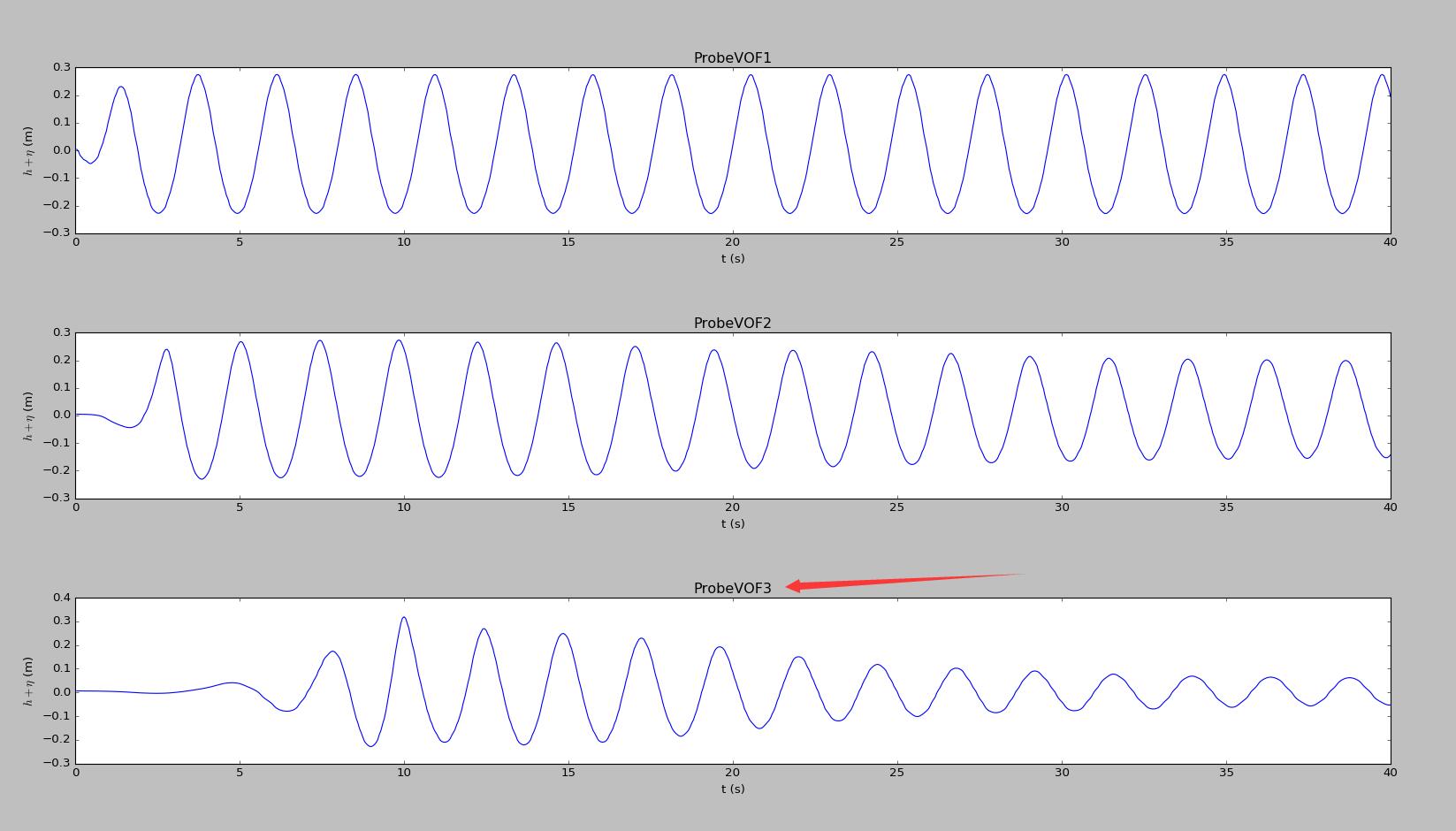 |
|
|
[Sponsors] | |||||
[waves2Foam] significant wave height dissipation when using the k omega model for wave simultation |
 |
|
|
LinkBack | Thread Tools | Search this Thread | Display Modes |
|
|
|
#1 |
|
New Member
Maoyanjun
Join Date: Jan 2016
Posts: 20
Rep Power: 10  |
Hello everyone:
I am using the waves2foam to generate Stokes II waves. But when I tried to use the k omega turbulence model or the k epsilon model, I got a significant dissipation of wave height. Is it normal or not? hope for your suggestions! -------------------------------- the wave condition is as follow: the length of the wave tank L =50m, the location of the Probes ProbeVOF1=5.0m away from the inlet; ProbeVOF2=10.0m; ProbeVOF3=20.0m; ProbeVOF4=30.0m; ProbeVOF5=49.0m; the wave height 0.5m;wave period T=2.4s,water depth h=10.0m ------------------------------------------ boundary conditions for k, $\omega$ and nut: k: ``` Code:
internalField uniform 0.001;
boundaryField
{
#includeEtc "caseDicts/setConstraintTypes"
inlet
{
type zeroGradient;
//value uniform 0.001;
// I have tried the fixedValue boundary, kqRWallFunction, also got similar results
}
outlet
{
type zeroGradient;
//value uniform 0.001;
// I have tried the fixedValue boundary, kqRWallFunction, also got similar results
}
bottom
{
type kqRWallFunction;
value uniform 0.001;
}
frontBack
{
type empty;
}
atmosphere
{
type inletOutlet;
inletValue uniform 0.001;
value uniform 0.001;
}
omega: ``` Code:
boundaryField
{
inlet
{
type zeroGradient;
//value $internalField;
}
outlet
{
type zeroGradient;
//value $internalField;
}
bottom
{
type omegaWallFunction;
value $internalField;
}
atmosphere
{
type inletOutlet;
inletValue $internalField;
value $internalField;
}
frontAndBack
{
type empty;
}
}
nut: ``` Code:
boundaryField
{
#includeEtc "caseDicts/setConstraintTypes"
inlet
{
type nutkWallFunction;
Cmu 0.09;
kappa 0.41;
E 9.8;
value uniform 0;
}
outlet
{
type nutkWallFunction;
Cmu 0.09;
kappa 0.41;
E 9.8;
value uniform 0;
}
bottom
{
type nutkWallFunction;
Cmu 0.09;
kappa 0.41;
E 9.8;
value uniform 0;
}
frontBack
{
type empty;
}
atmosphere
{
type calculated;
value uniform 0;
}
``` ___________________________ the surface elevation of this four probes:  
|
|
|
|

|
|
|
|
|
#2 |
|
New Member
Jente Vercammen
Join Date: Mar 2020
Posts: 9
Rep Power: 6  |
Hello,
Did you find a solution for the problem? I have the same problem? Kind regards Jente |
|
|
|

|
|
|
|
|
#3 |
|
Senior Member
Join Date: Mar 2014
Posts: 112
Rep Power: 12  |
Heavy dissipation on free surface is a well known problem on VOF modeling techniques specially with kOmega based turbulence models. As a solution you can find and try stabilized versions of the turbulence models or you can try higher order models such LienCubic kEpsilon.
|
|
|
|

|
|
|
|
|
#4 | |
|
New Member
Maoyanjun
Join Date: Jan 2016
Posts: 20
Rep Power: 10  |
Quote:
> Application of a buoyancy-modified k-ω SST turbulence model to simulate wave run-up around a monopile subjected to regular waves using OpenFOAM® these two papers have give an answer to this problem, but I have not tested them, hope for hearing more tests on these modefied turbulence models. |
||
|
|

|
||
|
|
|
#5 |
|
Member
Join Date: Apr 2015
Posts: 42
Rep Power: 11  |
I had experienced the same issue with OpenFOAM v1912 for the k-w sst model. The solution was to reduce the initial values of the KTE and omega, and to refine the mesh (smaller cells). This issue is mainly for structure-free regions. This is a known problem for incompressible VOF turbulence modelling and I could get the solution given here (fvOption) to work beyond a very short period of the onset of my simulations (https://www.openfoam.com/releases/op...nd-physics.php).
|
|
|
|

|
|
|
|
|
#6 |
|
New Member
irengclenk
Join Date: Feb 2021
Posts: 5
Rep Power: 5  |
So far, the best solution I can suggest is using the dissipation control as introduced in Larsen, B., & Fuhrman, D. (2018). On the over-production of turbulence beneath surface waves in Reynolds-averaged Navier–Stokes models. Journal of Fluid Mechanics, 853, 419-460. doi:10.1017/jfm.2018.577. The code is avalaible in here: https://github.com/BjarkeEltardLarsen?tab=repositories
|
|
|
|

|
|
 |
|
|
 Similar Threads
Similar Threads
|
||||
| Thread | Thread Starter | Forum | Replies | Last Post |
| Use of k-epsilon and k-omega Models | Jade M | Main CFD Forum | 40 | January 27, 2023 08:18 |
| Water subcooled boiling | Attesz | CFX | 7 | January 5, 2013 04:32 |
| eddy dissipation model: combustion doesn't occur | roukaia | FLUENT | 0 | December 24, 2011 10:10 |
| Low Reynolds k-epsilon model | YJZ | ANSYS | 1 | August 20, 2010 14:57 |
| Eddy dissipation model | ioana | CFX | 1 | June 10, 2004 15:15 |